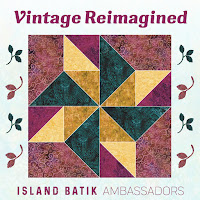I love bright colors, small pieces, and easy cutting and this baby quilt has all of that thanks to Island Batik and Accuquilt.
The main challenge for the Island Batik Ambassadors this month was to use the Accuquilt Go system to cut out our project.
Accuquilt graciously sent the 8 inch block bundle of the Ready. Set. Go! to the Island Batik Ambassadors this year.
The Ready. Set. Go! bundle comes with a book by Eleanor Burns that has instructions for making 46 different blocks using the dies that come in the bundle.
My quilt is made up from two blocks from the book:
Old Maid's Puzzle
and Flying Birds
Each block was alternated and set on point in the quilt
EQ8 helped me get the layout and colors I wanted.
EQ8 Version
Final Version
I used the Stash builder rolls sent to me by Island Batik as a 2019 Ambassador along with some yardage for this little quilt.
I cut every single shape using the Accuquilt.
I used dies #2, #3, and #5 for the blocks and used die #4, the quarter square triangles, to get the smaller yellow and pink half square triangles for the sides of the quilt
I love these half square triangle dies.
They cut perfect triangles every time with no dog ears, and they sew up perfect with no trimming down. I am hooked on these dies! I need one for every size HST!
I pieced together two small left over pieces of my Hobbs 80/20 batting for this one. I save all my leftover batting. Larger leftover pieces are perfect for smaller quilts.
I broke out my Aurfil Threads to quilt this one up. Patel yellow was used for the pink, green, and yellow fabrics and the blue went over the purples and blues.
The Auriful and the Hobbs combined sure made the quilting pop.
I got a break in the clouds for an outside picture at the park. I love the new park only two blocks from my house. The trees are turning green and getting g fresh piles of mulch. Check out the pile put on that tree on the left. You can never have too much mulch. Haha.
=^..^=






























































